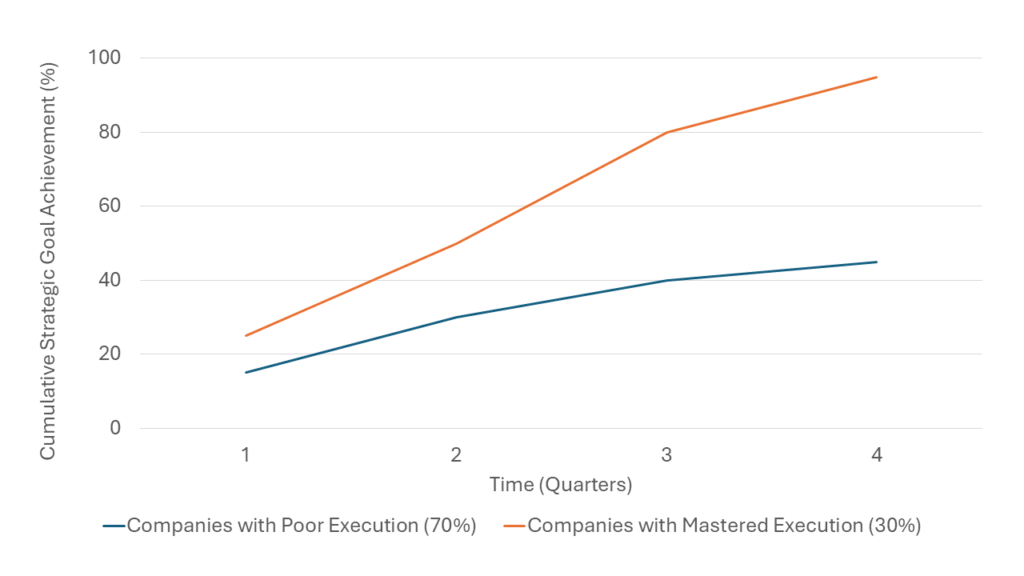Every year, leadership teams invest millions of dollars and countless hours in off-site meetings, reports, and rigorous analysis to develop a winning strategy. They emerge with a bold vision, ambitious goals, and a beautifully designed slide deck. And then, nothing happens.
This is the strategy-execution gap, the vast chasm between ambition and reality. It is the single greatest point of failure in business today. While the exact statistics are debated, our study shows that between 40% and 80% of strategies fail to deliver their intended results. The median hovers around a staggering 65%.
This failure is not a matter of bad strategy; it is a matter of bad execution. The hard truth is that crafting the strategy is the easy part. Making it happen is where the real work lies. This article deconstructs why this gap exists and provides an actionable framework to ensure your company lands in the successful 30%.
The Root Causes: Why Execution Fails
Understanding the failure modes is the first step to prevention. The gap is not caused by one thing, but by a system of interconnected breakdowns:
-
-
- The “Black Box” Communication Trap: Strategies are often communicated as a finished product, a set of lofty goals handed down from the mountain top. Employees, who are critical to execution, don’t understand the “why” behind the goals. They are expected to execute on a plan they had no hand in shaping and may not even believe in. This lack of buy-in is a primary execution killer.
- Static Planning in a Dynamic World: Many strategies are treated as annual events – a fixed, 100-page document that is obsolete the moment it’s printed. In a world of constant disruption, a strategy must be living, breathing framework that can adapt to new market data, competitive moves, and internal learning.
- Misalignment of Resources and Incentives: This is perhaps the most practical failure. Companies routinely approve ambitious strategic initiatives without reallocating budget, people, or time to accomplish them. Employees are expected to execute new, transformative work on top of their “day jobs.” Furthermore, if incentive structures and performance reviews reward old behaviors, the new strategy is dead on arrival.
- Lack of Accountability Cadence: Without a consistent rhythm of review, a relentless execution cadence, strategic priorities get drowned out by the daily urgencies of the business. Initiatives lose momentum, and progress isn’t tracked, allowing minor setbacks to become major roadblocks.
-
The Framework: How to Bridge the Gap
Bridging the gap requires moving from strategy as a document to strategy as a management system. This system is built on four pillars:
1. Co-Creation & Transparent Communication:
Stop announcing your strategy and start socializing it. Involve key influencers and managers from across the organization in the development process. Use workshops to pressure-test ideas and gather input. Once defined, communicate it with radical clarity, not just once, but repeatedly. Every leader must be able to articulate how their team’s work ladders up to the core strategic objectives.
2. From Vague Goals to Clear Metrics: The Power of OKRs
Objectives and Key Results (OKRs) have become the lingua franca of execution for a reason. This framework creates absolute clarity and alignment.
-
-
- Objectives are the qualitative, inspirational goals (the what).
- Key Results are the quantitative, measurable outcomes that define success (the how).
-
Cascading OKRs from the C-suite down to individual teams ensures everyone is pulling in the same direction, and their daily tasks are directly tied to strategic priorities.
3. Ruthless Resource Reallocation:
Strategy is resource allocation. Conduct a rigorous audit of your capital expenditure (CapEx) and operational expenditure (OpEx). Ask the hard question: “Are our financial and human resources funding our legacy operations or our future ambitions?” Be prepared to stop, start, and shift investments to fuel the strategic priorities. This is the most concrete signal that the strategy is real.
4. Implement a Cadence of Accountability:
Execution thrives on rhythm. Establish a predictable, disciplined meeting cadence dedicated solely to strategy execution – separate from operational updates.
-
-
- Weekly Check-Ins: Team-level meetings to review progress on Key Results and clear obstacles.
- Monthly Leadership Reviews: Cross-functional meetings to review strategic initiative health, resource alignment, and leading indicators.
- Quarterly Business Reviews (QBRs): A deep dive to assess progress, reflect on learning, and adapt OKRs for the next quarter.
-
This cadence creates a feedback loop that allows the organization to learn and adapt in real-time, making the strategy dynamic.
The Result: From Failure to Mastery
Companies that master this system create a virtuous cycle of execution. They don’t just plan; they perform. The difference in outcome is profound, as illustrated by the performance gap between those who master execution and those who don’t.

The Performance Gap: Mastery vs. Mediocrity in Execution
This chart demonstrates the powerful compound effect of a disciplined execution system. While poorly executing companies start to plateau as initiatives stall and focus wanes, mastering organizations maintain momentum, achieving near-total strategic goal attainment within a year.
Your First Step: Launch a “Quick Win” Initiative
Bridging the gap can feel daunting. Start with a single, quarter-long strategic initiative and apply the full framework:
-
-
- Define it with a clear Objective and 2-3 measurable Key Results.
- Dedicate a specific team and budget to it.
- Review it weekly and monthly without fail.
-
Use this project as a pilot to refine your execution system, demonstrate its value, and create a blueprint for scaling it across the entire organization.
The goal is not to have a perfect strategy, but to have a strategy that is perfectly executed. That is how you join the elite 30%.
Is your strategy destined to be a document or a result? Our consultants specialize in installing the frameworks and cadences that turn ambition into achievement. Contact us to close your strategy-execution gap for good.



